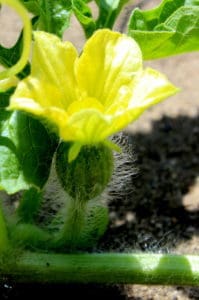Beekeepers in the Pacific Northwest are not blessed with the high honey yields of beekeepers in other regions of the country. They are more reliant on renting their bees to pollinate crops and fortunately the agriculture of the PNW has a variety and abundance of commercially grown crops that require or benefit from honeybee pollination. In our work as the PNW Tech Team, Ellen and I are fortunate to work with our beekeepers and sample their colonies while pollinating many different crops in the region. This is the first installment of a series of ‘Crop Pollination Profiles’ where I’ll outline the basics of cultivating each crop and the role the bees play.



Watermelon (Citrullus lanatus) is a vine-like annual in the Cucurbit family with cucumbers, squash, gourds and other melons. It favors an abundance of sunshine, warm nights and loose, well-drained soil.
Melons require a good deal of water and grow well in sandy/loamy soils with the aid of irrigation. Watermelons are commercially cultivated in raised soil rows with individual plants being spaced 2-3 feet apart with 5-8 feet between rows. Typically black plastic mulch with drip irrigation underneath is used to facilitate ideal growth conditions. The plastic sheeting provides several benefits including, increasing soil temperature, moisture retention, and weed control.

Often a cereal crop (e.g. wheat) is inter-sown between melon rows to provide windbreak and protect young plants.

Watermelon plants are self-fertile and bear separate male and female flowers on the same plant. Flowers are approximately 1-inch in diameter and range from pale to bright yellow.

The pollination window is drawn out over a few months with plants producing a new flush of blooms after picking mature fruits. Hired colonies are required for longer than most crops with colonies being placed in fields from late May until early September. Pollination rental rates are in the range of $60-$70/colony. While the overall bloom of a field is drawn out, individual female flowers are only receptive to pollination for a single day. Flowers open early in the morning and close by the afternoon with peak pollination occurring in mid-morning.
Proper pollination is essential to achieve well sized symmetrical fruits. Colonies are stocked at 1.5-2 colonies/acre depending on grower preference. Bees can forage pollen and nectar from watermelon but the flowers aren’t particular attractive if alternative forage exists nearby. Watermelon pollen is bright yellow and the photo below shows the lack of alternative forage available to bees in this field.

Due to the relatively low flower density, limited amount of pollen and nectar available, and extended duration of pollination bees may require supplemental feeding while in watermelons to remain in robust health.